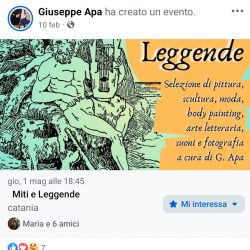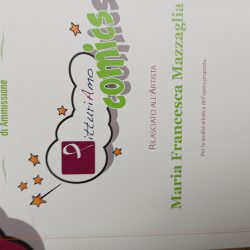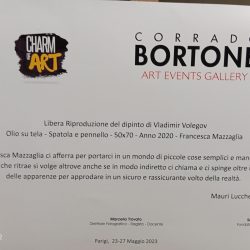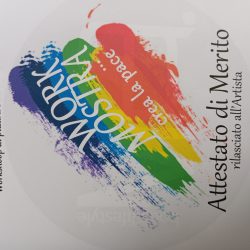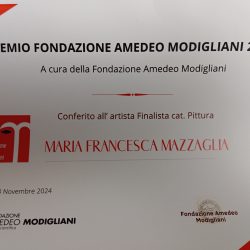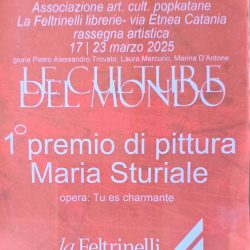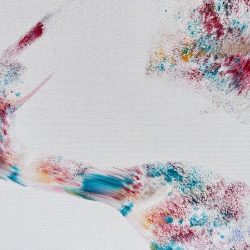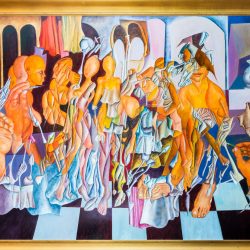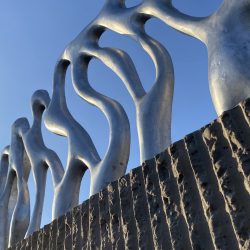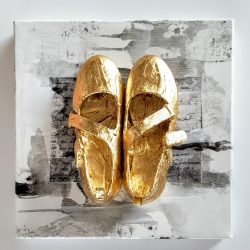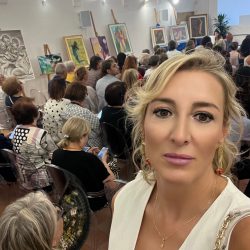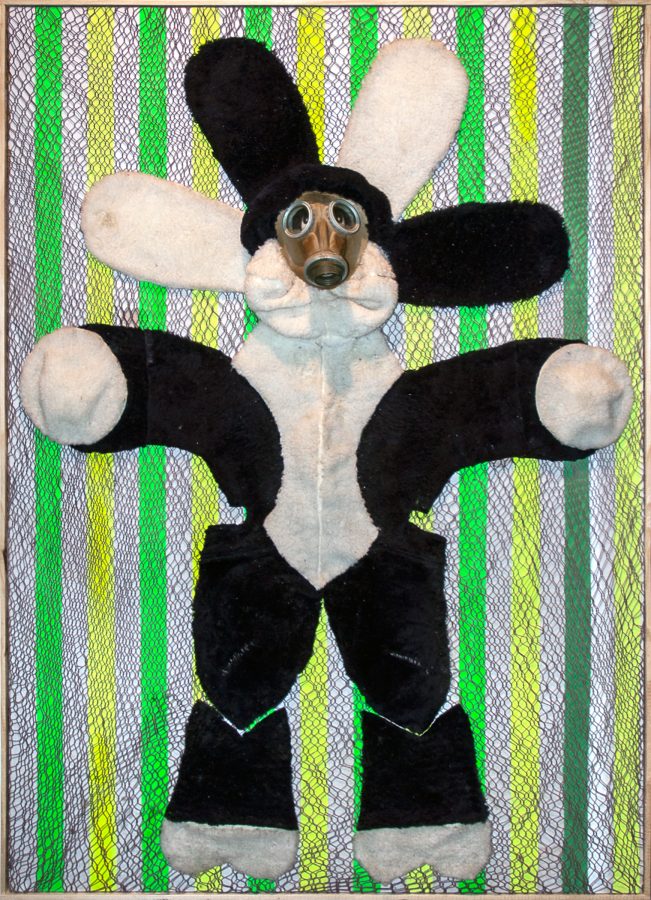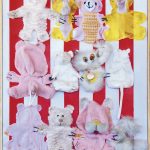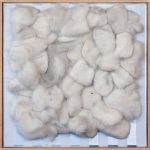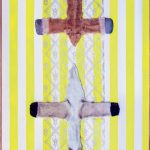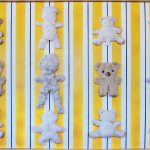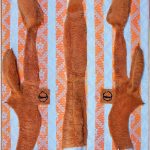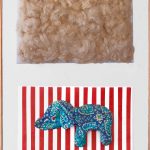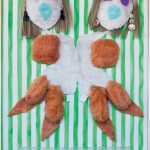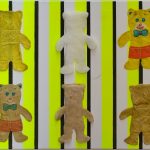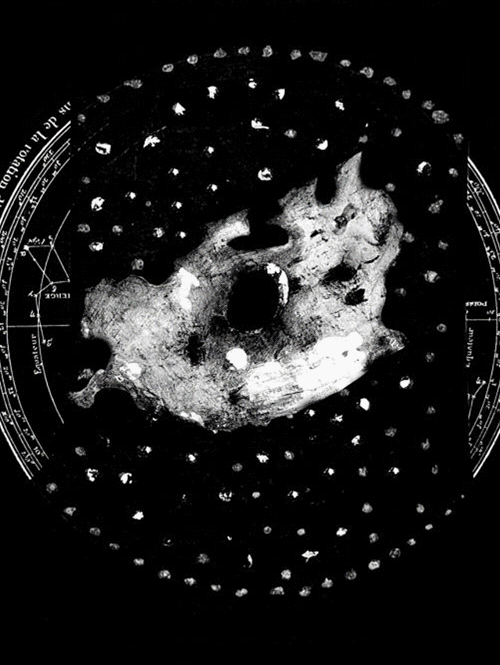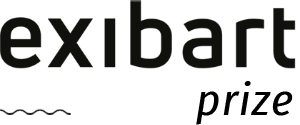“THE TRAGIC EQUILIBRIUM THAT SURROUNDS ME” (1)
The split times, through which there are realized, each according to its own logic, the different operations implemented by Maurizio Ruggiano (the “figured” sheets, the fluffy toys, the resin shapes, the objets trouvés, the video dedicated to the Doll) come together in a single judgment on the large sum that should contain them: History is broken up – each of these paths, reaching its conclusion, declares with its own single word – and “beautiful form” lacerated, reconciliation impossible. The negative discovery comes from the very voice of Destruction, faced openly. To testify to it, every function brought into play by this artistic gesture can act and appear whole only if it comes, like the very free homunculi of the sheets, from the untouchable sphere of dreaming a few moments after awakening; otherwise it can only show itself – material or virtual – “under the scar.” However, in the concrete acts of the works in which it manifests itself, this judgment on the irreversible shattering of the world does not choose disenchantment as its expression: these formal creatures rather promise activity and vengeance when, in different but mutually allied formations, they are finally distributed in the environment according to just parts and mandates, as is proper to the Summons as a precise aesthetic space.
But at the Summons all are already present in arms, after being recruited by the Seeker in two clearly identified territories: Dream and Chance. In full-night dreaming the schematic homunculi delegated with revolutionizing every given space appear with their own strength, to then be transferred during the day, with all their triumphant linear energy, onto the sheets, in the world of Icons that can be turned upside-down. In the informal territory of chance, instead, waiting allies, scattered everywhere in the outside world, are recognized precisely in their “off-centre” places. But their recognition implies oriented research. Not opaque indifference, in fact, but a constant internal counterpoint accompanies Ruggiano’s urban flânerie as a recognizer of meanings abandoned to loss, which emerge from anonymous street corners, from little shops, from supermarkets, from scraps, but are not consumption objects: Game as the first sacred representation in the realm of infancy is the original homeland that unites them and it is in the name of its redemption that they are identified and chosen. This unique land of origin marks the lost in dereliction: battered fluffy toys, Puppets of noble chivalric adventures in series in dented tin, the one-footed puppet hanging on the wall because it could not walk: a limping “Vitruvian.” The saved are not, however, redeemed as objects, but in their vocation as “characters”, as bearers of consciousness: led to speak – not with the voice but sending back the gaze – of “disfigured history.”
Gathering all the series in a single environment, the space of the Summons is therefore antagonistic: that of the stylized homunculi that overturn the canonical spaces of the sheets is a warrior world, and it is for the universal organization of the Revenge that there is rekindled, in every fluffy toy in the world that observes it, the implacable gaze of the Victim, and it is in view of a new tale that the epos in the heads of the beheaded Puppets attempts resurrection, protected by the aureole of the Resins as in a transparent armour.
Only in the video where human figures appear, concentrated around the inflatable doll, is no redemption present: its sequences mounted with traumatic flashes construct a negative theorem, in which every hypothesis of happy recomposition of History is contradicted by the impossibility of the Androgyne in daily life. In the “demonstration”, conducted sequence after sequence not as a narrative but with syncopated associative logic (2), the Opposites remain separate even beyond the violent display of their conflict, each flying towards their own different sky, so in turn the coupling with the artificial Feminine does not give rise to pathos and the virtual Feminine expresses itself in the final denying fiction, and with this also the filmic illusion, all truth: the concrete realization of the Androgyne that could harmonize it, also the future of time, in The Doll, absolutely coincides with Fracture as the original omnipotent model.
“AT LAST HE OPENS IT, HE IS THE STRONGEST. BUT WHERE IS THE SOUL? HERE DIZZINESS AND SADNESS BEGIN” (3)
In the world of Ruggiano’s fluffy toys the model of the Fetish (constructed and then revered) is a function of emancipation of the Scheme and of Copy – immanent to the industrially reproducible toy – from the exercise of the death principle to which the serial imagery would condemn them. In the figure of the toy, which from the crossing of the underworld under the guidance of the artist-psychopomp rises purified and wise within the composite tapestries and the “votive pictures”, the stakes are all childhood as the privileged territory of the Symbolic. But Symbol and Innocence bear on themselves the stigmata of the age or do not exist, and therefore in the highly developed contemporary condition they can only present themselves as problematic: apparently harmonious and harmonizing, but constitutionally “wounded.”
The scar is a glory for the “critical” toy. Precisely exhibited in Ruggiano’s compositions, it appears as an indelible and determined characteristic of the fluffy toy as a gnosiological model. When the process to which the fluffy toys are subjected obeys the mandate of Transformation, the scar is the final mark placed on the form. In this modality the most properly ritual phase takes place in a mysterious way, and therefore is only visible to the officiant and not to the external world, while the cultic phase can finally expose the sacrificial lamb to its new (cicatrized) splendour. However, in Ruggiano’s praxis only the whole process gives rise to meaning, and therefore every secret phase is also enlightened, even as a formal intention, by the final purpose of the opus. Thus solitary research, identification and collection of the Derelict in the urban environment are also part, as necessary preliminaries, of the rite for the restoration of Value, which each time is accomplished through dismemberment of the Whole, the concrete manipulation of Grief, incest and sacrilege in the mixture of new material with the original contained in the body of the puppet or doll, until the conclusive stitching of the edges around the violated internal abyss. But the entire sacrificial rite is accomplished for the reactivation of Value in residual industrial products with the appearance of toys: the general state of “disfigured history” on which Ruggiano’s gesture reflects therefore also applies to Innocence that presents itself – artificial and unwitting – in series.
Only after crossing death does the Fluffy toy as a Victim enter the world of Law, which coincides with the fenced background, bigger or smaller, geometrically decorated, in which it is placed and from which it now finally “looks”: it is precisely the return of the gaze to the world that observes them, a witting or a unwitting accomplice of their drift, the organizing principle of the great revenge that the Fluffy toys marked by the wound promise, building up in increasing numbers within the “tapestries” or between the single frames. In the new space reconstituted by the reciprocity of the glances and the unbalancing of the boundary between winners and vanquished, the momentary viewer of the Work suddenly emerges to himself or herself as the accused: the quiet daytime inhabitant of Guilt.
“THE MARIONETTE ONLY NEEDS LAND AS ELVES DO, TO TOUCH LIGHTLY ON IT” (4)
But there is not only Transformation: in the more recent cycle of the Fluffy toys the scar as a fundamental drive and testimonial proof of the sacrifice gives way to the toy smiling with open arms or legs, in a welcoming attitude but sewn with visible threads to the background: alone in the field or confused among the mass of its like clones, in separate series or thickly grouped together (“Bonds”), intact or divided into strips that present, contiguous on the same surface, the different points of view that should make up the all-round fictitious unity of the body, celebrated only by the name (“Self-portrait in pieces”). In this modality, the Module challenges the rigid convention of the spaces in which it is confined, and precisely remaining motionless but exhibiting the recto and the verso, the left and right side, the inside and the outside of the Fluffy toys, flattened together on the same background, places in a vortex the univocal concept of identity and its iconic projection in the “figure.” The new cycle of the Fluffy toys appears more properly as a sum of visual theorems on the relativity of perspective and of canonical spatial categories, and on their inadequacy, as dogmatic concepts, to recount “true life”: a model, in this sense, is “Two horses seen from below”, which flattens in a cross in the foreground the lower part of the Fluffy toy, turning upside-down the “normalized” point of view on history, or “Organic exterior”, which proposes in a square measure the modulated artificial matter extracted from the Fluffy toy of which, in the lower part of the same table, the “Left side and Right side” are shown: the two external parts not united but separated, in their delicate floral blue covering. (5)
“PARADISE IS SERRATED AND THE CHERUBIM IS BEHIND US” (6)
Among the creatures involved in the Summons, the arcane character with a human form, held within the transparent resin backdrop like an icon on the pictorial board or a bas-relief on stone, is an assemblage of objets trouvés that brings to a sacral dimensions the critical practice of Montage. In the same resin-coated board there is inserted a manikin of transparent plastic, half-length, and the bare iron structure destined, in common use, to lock and unlock the windows, but here in an upside-down position, so that its lateral supports appear as prostheses or crutches designed to proceed with the shape that, split between its two halves, bears within itself two pregnancies: the foetuses are the decapitated heads of Sicilian Puppets traced down among the conventional low-price series on the market. Inside the head of the silhouette, showing through the plastic, a couple stands still: the One with his double; other heads of this generation without bodies are placed in good order in the cavity of the belly. What is “Schizophrenic” here is History, rather than the psyche, and the montage of this paradoxical pregnancy on its way is its dumb and inexorable metaphor. However, the new time advances, just like an imperfect chrysalis. Immobile in the suspended movement, the transparent shape exposes to the world the positive and the negative of its artificial unity: ECCE HOMO. Almost osmotically related to the blocking or unlocking structure of the opening on the world, the figure itself, a paradigm of the generative mystery, possesses the keys of stasis or of even imperfect becoming, going beyond. The humble resin board that contains it and surrounds it has the task of constructing around it, at the beginning of its journey, a halo of light and a substantial aura, as befits every image of History that wants to find a foundation not in nothingness but in meaning.
I SPEAK OF THE SOLITARY CHILD THAT ALONE GOVERNS TWO ARMIES AND LEADS THEM TO BATTLE (7)
The schematic homunculi drawn on the sheets on first awakening and given a background in the afternoon are entrusted, among Ruggiano’s formal creatures, with the function of being Subversives. Emerging directly from dreams, in order to manifest themselves as signs on the sheets, they choose the childlike appearance of elementary urban graffiti. The fact that the sheets that contain them are limited in size is nothing but a challenge for the revolts that these figures enact in the spaces given by overwhelming them and strangling them: from every place, the liberators announce, the overturning of the Order can start. It is no coincidence that merriness, irony and ferocity characterize these functions of movement: in them the Schema acts freely like a childhood warrior. It is the rational afternoon that will add, behind every adventure of the morning homunculi, a system of abstract linear rules, traced out with chromatic violence. The double time of these compositions holds by the reins the organic side and the conceptual one of the Aesthetic: as in the compositions with the Fluffy toys, in fact, even in Ruggiano’s sheets the background is the bearer of the Code: not by chance (whether it is paper from pre-printed packs or sheets hand-marked by oil pastels) it always takes on a geometric formulation. In this case repetition coincides with a formal principle: marked dissonance, with respect to objects and graphemes, of their regular abstract, ordered, anonymous and often chromatically violent backgrounds thematizes the aesthetic problem of Symmetry: authoritarian or organic. The latter is imperfect: for it the One is illusion or fiction, an ever-trembling external seam ready again to be chipped. By contrast, abstract symmetry is the model, which is independent of the breath. In Ruggiano’s compositions this conflict is expressed in the contemporary actions of stage and backdrop: hence theatrically. However, the background does not only speak of problematic symmetry in these operations: it introduces, behind the “serial” existentialism of homunculi, puppets and dolls, a counterpoint: that of Form as a sovereign current, which precisely appointed by the linear rule flows autonomously. This presence constantly alluded to indicates that Ruggiano’s gesture (which gathers and restores meaning), although moving in the “lateral” world of toys and Puppets, is not naïve but wise (8): these territories are a challenge for the contemporary imagination of developed worlds, and the artistic will oriented towards clash chooses them precisely for this reason.
“- Thus grace is also found, after knowledge, so to speak, has crossed infinity; so that, at the same time, it appears very pure in that human construction that has either no consciousness or infinite consciousness, that is to say in the marionette or in God.- -So, I answered a little absentmindedly- should we savour again the tree of knowledge, to fall back into the state of innocence? –
- Certainly, he answered, this is the last chapter in the history of the world. “(9)
Luciana Rogozinski
N O T E
1) Maurizio Ruggiano, from the DIARY.
2) The associative logic through splinters of sequences in which filmic discourse repeats itself as a trauma or is interpolated by recorded voices, quotations of documentaries or historical films (in THE DOLL the beloved Buñuel) is characteristic of Ruggiano’s video operations and corresponds to an anti-narrative modality: in addition to the aesthetic choice of highlighting the montage more than the story, the filmic splinters express a theory: “the first fault”, “the original event” generates the shattering of any world, even of the story itself as a microcosm .
3) C. Baudelaire, “Morale del giocattolo”, in Morale del giocattolo. Rilke, Baudelaire, Kleist. Tre incursioni nell’immaginario dell’infanzia, ed. L.Traverso, Stampa alternativa Nuovi equilibri, 1991.
4) H. Kleist, “Sul teatro di marionette” in Morale del giocattolo. Rilke, Baudelaire, Kleist. Tre incursioni nell’immaginario dell’infanzia.
5) By bringing together in a single table “Organic exterior” and “Interior, Left side and Right side” this operation steers Manzoni’s “materialist” lesson towards the exposed material, to deconstruct, here, the illusion of the Whole.
6) H. Kleist, “Sul teatro di marionette.”
7) C .Baudelaire, “Morale del giocattolo.”
8) In Ruggiano’s gesture there converge many different techniques of visual practice, video film and micro-drama and constant critical use of montage in these expressions. The willingness to use each of these means for the primacy of the message is what makes it possible to attribute meaning to any natural or artificial element traced in the world: therefore placing “lateral” elements on surfaces and between frames assimilates them to sacred icons in votive kiosks. The origin of these secular tabernacles is the urban street, in which the alienating images suddenly appear in a corner: the space and the adventure of antagonistic imagination begin from there.
9) H. Kleist, “Sul teatro di marionette.”
progetti
autoterapia
| category | Exhibition |
| location | Palermo (Sicily - Italy) |
| deadline | 29 Sep 2021 |
Exhibition



